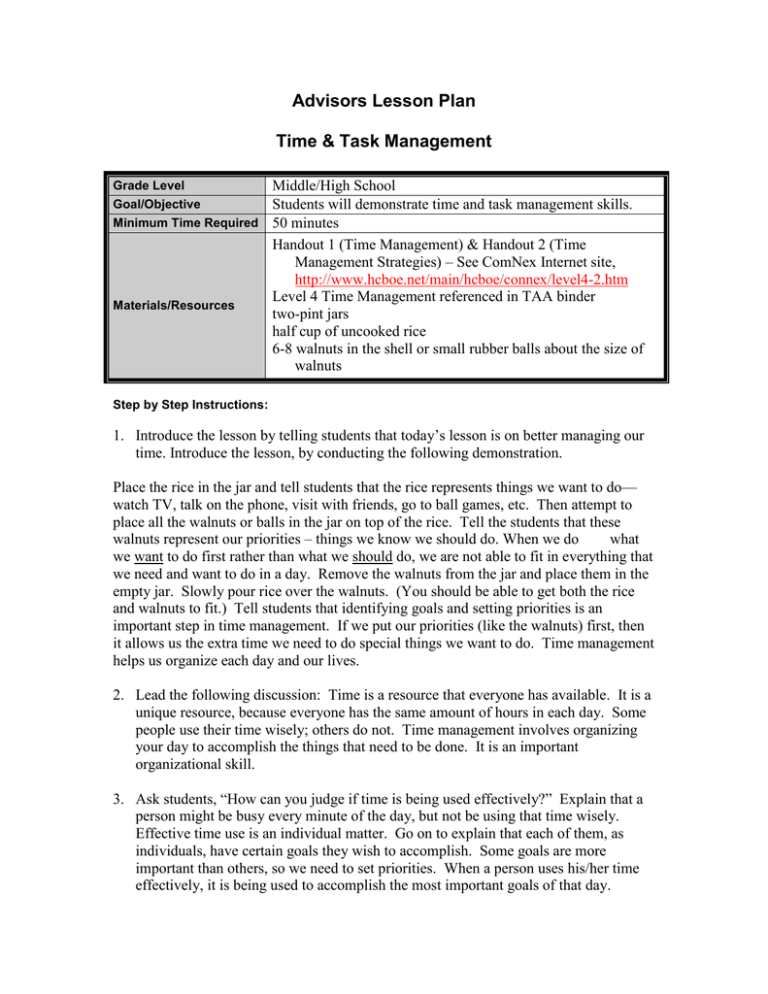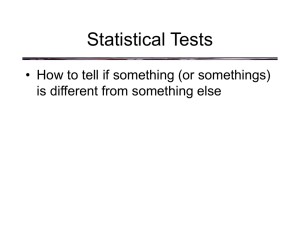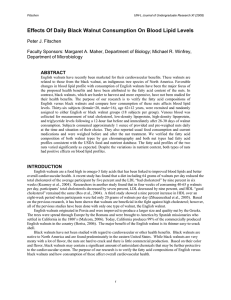Advisors Lesson Plan Time & Task Management
advertisement

Advisors Lesson Plan Time & Task Management Middle/High School Students will demonstrate time and task management skills. Minimum Time Required 50 minutes Handout 1 (Time Management) & Handout 2 (Time Management Strategies) – See ComNex Internet site, http://www.hcboe.net/main/hcboe/connex/level4-2.htm Level 4 Time Management referenced in TAA binder Materials/Resources two-pint jars half cup of uncooked rice 6-8 walnuts in the shell or small rubber balls about the size of walnuts Grade Level Goal/Objective Step by Step Instructions: 1. Introduce the lesson by telling students that today’s lesson is on better managing our time. Introduce the lesson, by conducting the following demonstration. Place the rice in the jar and tell students that the rice represents things we want to do— watch TV, talk on the phone, visit with friends, go to ball games, etc. Then attempt to place all the walnuts or balls in the jar on top of the rice. Tell the students that these walnuts represent our priorities – things we know we should do. When we do what we want to do first rather than what we should do, we are not able to fit in everything that we need and want to do in a day. Remove the walnuts from the jar and place them in the empty jar. Slowly pour rice over the walnuts. (You should be able to get both the rice and walnuts to fit.) Tell students that identifying goals and setting priorities is an important step in time management. If we put our priorities (like the walnuts) first, then it allows us the extra time we need to do special things we want to do. Time management helps us organize each day and our lives. 2. Lead the following discussion: Time is a resource that everyone has available. It is a unique resource, because everyone has the same amount of hours in each day. Some people use their time wisely; others do not. Time management involves organizing your day to accomplish the things that need to be done. It is an important organizational skill. 3. Ask students, “How can you judge if time is being used effectively?” Explain that a person might be busy every minute of the day, but not be using that time wisely. Effective time use is an individual matter. Go on to explain that each of them, as individuals, have certain goals they wish to accomplish. Some goals are more important than others, so we need to set priorities. When a person uses his/her time effectively, it is being used to accomplish the most important goals of that day. For most people, much of their time use is predetermined. For instance, as a high school student, an average 24-hour day involves school from perhaps 8:00 to 3:00, then time for personal grooming, homework, thinking, planning, creating, sports activities or other extra-curricular activities. The way you use your time is constantly changing as you develop new interests and assume new responsibilities. Your use of time as a seven-year-old was certainly different from the way you use your time now. 4. Explain to students that one of the first steps in improving time use is to keep a record of how you presently use your time. A time record or log can be helpful in identifying time wasters. 5. Distribute the Time Management handout #1. Read the directions to students and have them calculate the hours spent in the listed activities. This will determine their free time. 6. Explain that when a resource is limited, careful planning for the use of that resource becomes very important. For the parent who works outside the home, time becomes a very limited resource that must be managed carefully. There are meals to be prepared for the family and cleaning, shopping and laundry to be done. In contrast, for a child who has few tasks to assume, time is not such a limited resource. Therefore, the child does not feel the pressure to manage time as well. 7. Distribute the Time Management Strategies, handout #2. Read Handout 2 to students, and ask them to complete. Allow at least five minutes for them to complete both handouts Domain/Standard Academic Standards Language Arts Employability/SCANS Skills Assessment Rubric Credits for sources: Academic Development Listening and Viewing Indicator 1: Students are able to use various listening and viewing strategies in social, academic, and occupational situations. Basic Skills, Personal Qualities Class Participation; In Class Assignment

